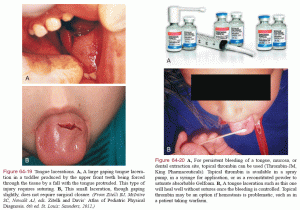You’re working your pediatric shift and you see your next patient. It’s a young boy who while running had fallen and hit his head, had initially had some bleeding from the mouth and was crying but is now better and no longer bleeding. His mom brought him in cause she found a cut on his tongue which was sometimes bothering the child especially when eating. You take a look and see a small tongue laceration towards the center of the tongue without any current bleeding. So what do you do?
Tongue lacerations can sometimes be difficult to manage depending on their severity, but fortunately most do not require any repair if hemostasis can be achieved. The only ones that truly need repair are larger complicated lacerations that gape, profusely bleeding wounds, are flap shaped, involve muscles, or are on the edge of the tongue. Even larger lacerations with edges that approximate will heal well without any intervention.
And what if hemostasis can’t be achieved? Topical TXA can also be used in order to aid in that endeavor. Gelfoam impregnated with TXA is also an option for severe bleeds but primary repair would be indicated in those cases. Below is a nice image of examples.
Bottom Line: Majority of tongue lacerations do not require repair. Evaluate thoroughly before poking in needles.
References:
Roberts, James R., et al. Roberts and Hedges’ Clinical Procedures in Emergency Medicine and Acute Care. Elsevier, 2019.

